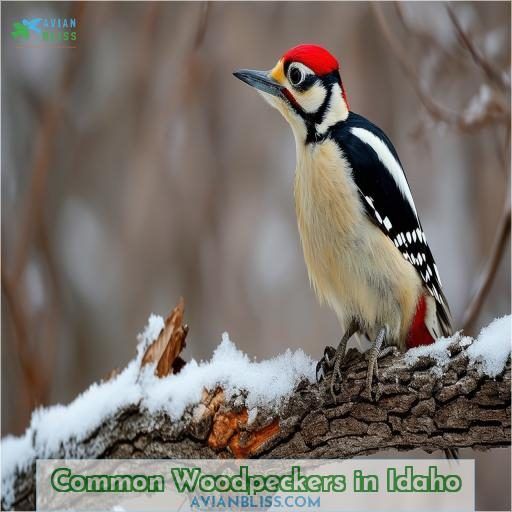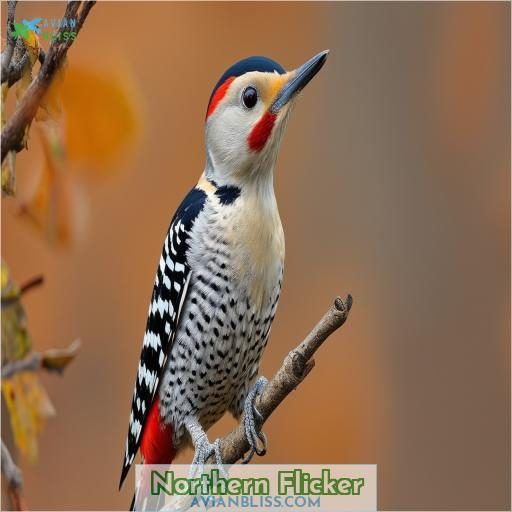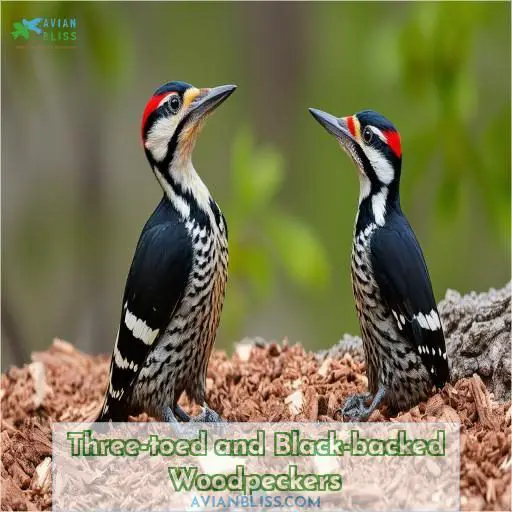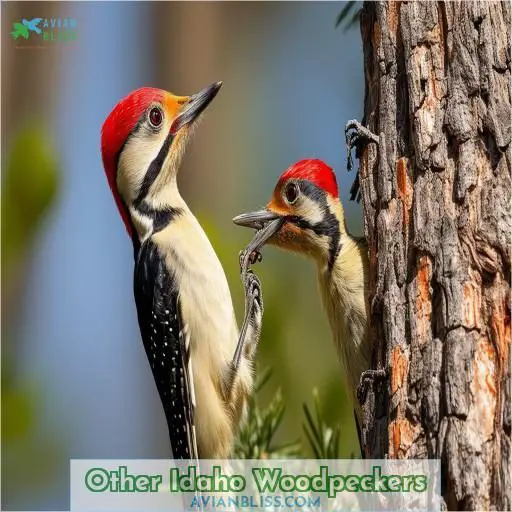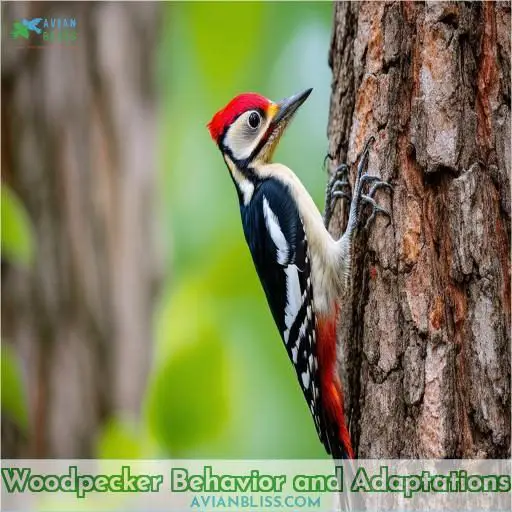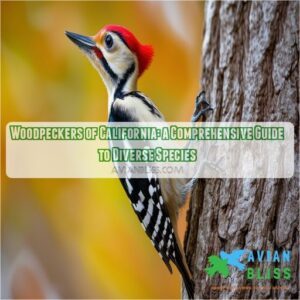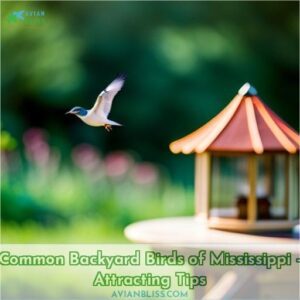This site is supported by our readers. We may earn a commission, at no cost to you, if you purchase through links.
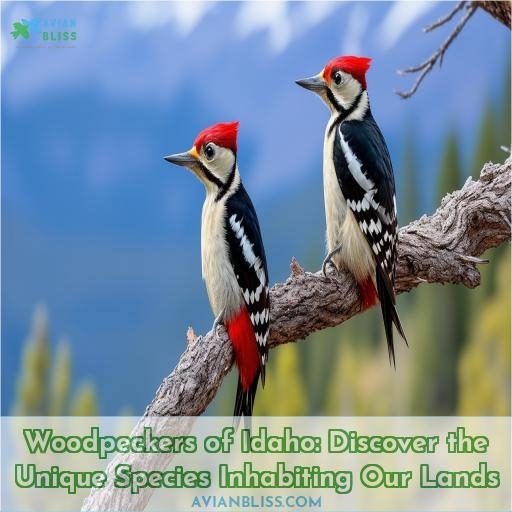 The woodpeckers of Idaho! You’re in for a treat. These remarkable birds have adapted to thrive in our state’s diverse habitats, from dense forests to open woodlands.
The woodpeckers of Idaho! You’re in for a treat. These remarkable birds have adapted to thrive in our state’s diverse habitats, from dense forests to open woodlands.
The iconic Pileated Woodpecker, with its striking red crest, is expanding eastward. The petite Downy and acrobatic Hairy Woodpeckers share their domain.
The Northern Flicker favors semi-open areas. But there’s more – sapsuckers, three-toed woodpeckers, and others await your discovery.
Prepare to be captivated by their unique behaviors and ingenious adaptations.
Table Of Contents
- Key Takeaways
- Common Woodpeckers in Idaho
- Pileated Woodpecker
- Downy Woodpecker
- Hairy Woodpecker
- Northern Flicker
- Lewis’s Woodpecker
- Sapsuckers in Idaho
- Three-toed and Black-backed Woodpeckers
- Other Idaho Woodpeckers
- Woodpecker Behavior and Adaptations
- Frequently Asked Questions (FAQs)
- What is the largest woodpecker in Idaho?
- What does it mean if a woodpecker is pecking my house?
- What bird looks like a woodpecker but isn t?
- What woodpeckers look like ivory-billed woodpecker?
- Are woodpeckers considered beneficial or harmful to trees?
- How long do different woodpecker species typically live?
- What predators pose a threat to woodpeckers?
- Can woodpeckers cause structural damage to houses?
- Are any woodpecker species endangered in Idaho?
- Conclusion
Key Takeaways
- Idaho’s diverse habitats – from dense forests to open woodlands – provide a mecca for an array of fascinating woodpecker species, each one a feathered carpenter with its own unique quirks and adaptations.
- Prepare to be dazzled by the spectacle of the majestic Pileated Woodpecker, nature’s own demolition expert, whose striking crimson crest and incessant jackhammering on tree trunks adds a touch of drama to your woodland wanderings.
- Keep your eyes peeled and ears tuned for the acrobatic antics of the petite Downy Woodpecker and its larger doppelganger, the Hairy, as they defy gravity and scale tree bark like avian Spider-Men in their relentless pursuit of insect prey.
- From the Northern Flicker’s undulating flight and quirky "wick-a-wick-a-wick" calls to the Lewis’s Woodpecker’s striking pink belly and insect-catching aerial maneuvers, these charismatic feathered performers will have you applauding nature’s boundless creativity.
Common Woodpeckers in Idaho
You’re about to begin a journey to discover the remarkable woodpeckers that call Idaho home.
From the majestic Pileated Woodpecker to the tiny downy, these feathered carpenters play an important role in maintaining our forests’ health.
Each species has adapted unique behaviors and diets to thrive in their habitats.
Some, like the hairy woodpecker, feast on wood-boring insects.
Others, like the sapsuckers, tap into trees for their sugary sap.
Explore their intricate nesting habits, from chiseling out cavities to raising their broods.
Learn how to identify them by their distinct markings and calls.
Pileated Woodpecker
Let’s examine the pileated woodpecker’s range, appearance, and behavior. This strikingly large woodpecker inhabits various forested areas across Idaho, distinguished by its striking black body adorned with white stripes on the neck and a brilliant red crest.
Pileated Woodpecker Range Map
Speaking of pileated woodpeckers, you’ll find these striking birds across Idaho, their range expanding eastward in recent decades. Despite population declines historically, conservation efforts and forest regrowth have allowed them to repopulate suitable habitats. As you explore Idaho’s woodlands, keep an eye out for these magnificent woodpeckers clinging to tree trunks – a sure sign of a thriving ecosystem.
Identification and Behavior
You’ll easily identify the pileated woodpecker, our largest woodpecker, by its striking size (larger than a crow) and brilliant red crest. Listen for its distinctive drumming on dead trees as it forages in mature forests. These monogamous birds mate for life, excavating new nest cavities each year using their chisel-like beaks and incredible shock-absorbing anatomy.
Downy Woodpecker
After exploring the majestic pileated woodpecker, let’s turn our attention to one of Idaho’s smaller woodpecker species – the downy woodpecker.
This petite black and white bird, just 6-7 inches long, is a year-round resident found in woodlands across the state.
With its characteristic white back, black wings with white spots, and a tiny black-tipped bill, the downy is a frequent visitor to backyard feeders.
These cavity-nesters excavate nest holes in decaying trees or wooden structures, where they raise a single brood annually on a diet of insects and plant matter.
Keep an eye out for their distinctive staccato drumming as they forage along tree trunks and branches.
Hairy Woodpecker
The Hairy Woodpecker’s range overlaps with the diminutive Downy Woodpecker across much of Idaho, making distinguishing between the two essential. While similar in appearance, the Hairy Woodpecker boasts a proportionately longer bill and lacks the Downy’s clean white outer tail feathers, allowing for reliable identification through close observation.
Hairy Woodpecker Range Map
You’ll find the Hairy Woodpecker across Idaho’s forests, parks, and suburban areas. Its range is expanding due to increasing tree cover. Monitor population trends as woodpeckers signal ecosystem health. Appreciate their unique behavior—territorial drumming, acrobatic foraging for insects, excavating nesting cavities. Preserving diverse habitats guarantees these entertaining residents endure.
Distinguishing Downy and Hairy
You might mistake the downy for the larger hairy woodpecker, but here’s how to tell them apart:
- Size: Downy is small (6-7 inches), while hairy is larger (7-9 inches)
- Bill: Downy has a short, stubby bill; hairy’s is longer and thicker
- Outer tail feathers: Downy’s are spotted, hairy’s are plain white
- Habitat: Downy prefers deciduous forests, hairy likes mixed woods
Knowing these key differences will help you identify these two commonly confused woodpeckers.
Northern Flicker
Speaking of woodpeckers, you’ll often spot the Northern Flicker in Idaho – a brown bird with black spots and a distinctive red crescent on the nape.
These quirky fellows prefer semi-open habitats like woodlands, parks, and residential areas. Their diet consists mainly of ants and beetle larvae, which they expertly extract with their long, Barbed tongues.
Watch them hammer on tree trunks or even occasionally on the ground! Their curved beaks and shock-absorbing skulls make them masters at this foraging technique.
Northern Flickers are quite the entertainers – keep an eye out for their signature undulating flight and unique "wick-a-wick-a-wick" calls echoing through the trees.
Lewis’s Woodpecker
With its striking pink belly and greenish-black plumage, the Lewis’s Woodpecker stands out among Idaho’s woodpeckers.
These migratory birds prefer open pine forests and burned areas, where they forage for insects by flycatching and probing bark crevices.
Breeding pairs create nest cavities in dead trees or utility poles, laying 4-9 eggs. Their unique behaviors, like caching food and catching insects mid-air, make them a delight to observe.
Unfortunately, habitat loss poses a threat to Lewis’s Woodpecker populations. By preserving their preferred habitat of burned pine forests, we can safeguard these charismatic birds to continue gracing our state.
Sapsuckers in Idaho
In Idaho, the ranges of two sapsucker species overlap: the Red-naped Sapsucker and the Williamson’s Sapsucker. These woodpeckers are distinguished by their bold plumage patterns, with the Red-naped sporting a black back, white undersides, and red nape, while the Williamson’s displays a striking black, white, and red throat pattern.
Red-naped Sapsucker Range Map
As you explore Idaho’s forests, keep an eye out for the striking red-naped sapsucker. These black-and-white woodpeckers with their signature red nape migrate through the state, favoring mixed forests for nesting and feeding on sap wells they drill in trees. Understanding their habitat needs and migratory patterns aids conservation efforts for this unique species.
Williamson’s Sapsucker Range Map
You’ll also want to study the Williamson’s Sapsucker range map. These woodpeckers migrate from the Pacific Northwest to Mexico and back annually. They prefer coniferous forests and eat sap, insects, and tree cambium. During nesting season, look for nest cavities in deciduous trees. Conservation efforts protect this species’ breeding habitat.
Three-toed and Black-backed Woodpeckers
The American Three-toed Woodpecker and Black-backed Woodpecker are two distinct species that inhabit parts of Idaho, with range maps illustrating their respective territories. These woodpeckers exhibit unique characteristics and behaviors that separate them from other species, making them fascinating subjects for nature enthusiasts and ornithologists alike.
American Three-toed Woodpecker Range Map
The American Three-toed Woodpecker’s range map includes:
- Northern forests across Canada and Alaska
- Mountainous regions of the western U.S.
- Small pockets in the northeast and upper Midwest
This woodpecker thrives in areas with:
- Mature coniferous or mixed forests
- Standing dead trees for nesting cavities
- Outbreaks of wood-boring beetles for food
Black-backed Woodpecker Range Map
While the Black-backed Woodpecker shares part of its range with the American Three-toed, their habitats differ. Observe their competitive interactions:
| Black-backed | Range Overlap | American Three-toed |
|---|---|---|
| Burns, beetle-killed forests | Moderate | Mature coniferous forests |
| Newly disturbed areas | High | Older burned, diseased areas |
| Nests in dead stubs | Moderate | Nests in live, decaying trees |
Understanding their range overlap aids conservation efforts for these unique species.
Other Idaho Woodpeckers
In Idaho, you’ll also encounter the quirky Acorn Woodpecker, sporting a clownish black-and-white face with a jaunty red cap. The Red-headed Woodpecker is a real showstopper with its vivid crimson head and snowy-white belly. And don’t overlook the Red-bellied Woodpecker, named for its subtle reddish blush despite its pale underside. Idaho boasts an impressive diversity of woodpeckers, each one a unique ambassador for our state’s rich natural heritage. Here are four reasons why these avian neighbors enrich our lives:
- Their drumming serenades remind us of nature’s rhythms
- Their colorful plumages brighten our days
- Their resilience inspires us to persevere
- Their presence signals a healthy, thriving ecosystem
Woodpecker Behavior and Adaptations
You’ll be amazed by the incredible adaptations that allow woodpeckers to thrive. Their tongues can extend far beyond their bills, coated with sticky barbs to extract insect prey.
But what’s truly mind-boggling are the shock-absorbing mechanisms that protect their brains as they jackhammer into trees. Picture spongy bones, reinforced skulls, and even a unique hyoid bone that wraps around the skull—all evolved to withstand forces up to 1,000 times gravity!
From excavating nests to gleaning insects, woodpeckers’ specialized diets and feeding behaviors showcase nature’s ingenious designs. Get ready to be wowed by these feathered carpenters!
Frequently Asked Questions (FAQs)
What is the largest woodpecker in Idaho?
Picture the colossal pileated woodpecker, an avian behemoth dominating Idaho’s forests with its impressive 30-inch wingspan and striking crimson crest. This mighty woodpecker, with its indomitable chisel-like beak, reigns supreme as Idaho’s largest species.
What does it mean if a woodpecker is pecking my house?
If a woodpecker is pecking your house, it’s likely searching for insects, resonating wood, or establishing territory. While harmless, the constant drumming noise and potential damage warrant deterring the bird humanely before issues escalate.
What bird looks like a woodpecker but isn t?
You may be surprised to see a bird that resembles a woodpecker but lacks that signature drilling beak. Nuthatches, for instance, are small songbirds that often cling upside-down to tree trunks and branches, visually imitating woodpeckers’ behavior while lacking their specialized anatomy.
What woodpeckers look like ivory-billed woodpecker?
You might mistake the ivory-billed woodpecker for pileated woodpeckers, with their striking black-and-white plumage and red crests. However, the ivory-billed is larger, with white markings on the wings and lacks the pileated’s flaming red mustache-like markings.
Are woodpeckers considered beneficial or harmful to trees?
Woodpeckers are generally beneficial, as they aid in forest health by devouring wood-boring insects and opening bark for insect control. However, excessive drilling can harm individual trees by allowing disease or pest entry.
How long do different woodpecker species typically live?
Coincidentally, woodpecker lifespans differ substantially. Smaller species like the downy woodpecker live around 4-6 years, while larger ones like the pileated can reach 12 years in the wild.
What predators pose a threat to woodpeckers?
Woodpeckers’ primary predators include hawks, owls, snakes, and small carnivores like raccoons, weasels and martens. Their well-camouflaged nests provide safety, but eggs and nestlings remain vulnerable.
Can woodpeckers cause structural damage to houses?
Yes, woodpeckers can cause structural damage by drilling holes in wood siding, eaves, and trim. Their strong beaks can create sizeable cavities, allowing moisture and insects to enter the home. Take preventative measures to deter woodpeckers and avoid costly repairs.
Are any woodpecker species endangered in Idaho?
No, you’ll be glad to know that no woodpecker species in Idaho are currently listed as endangered. However, habitat loss remains a threat, so conservation efforts aim to protect these remarkable birds and their forest homes.
Conclusion
With mighty beaks carving their legacy, the woodpeckers of Idaho showcase nature’s resourcefulness. Whether you witness the Pileated’s regal presence, the Downy’s delicate foraging, or the Flicker’s ground-dwelling antics, these feathered wonders will captivate your senses. Embrace the opportunity to observe their ingenious behaviors and marvel at the biodiversity flourishing within our state’s boundaries.

